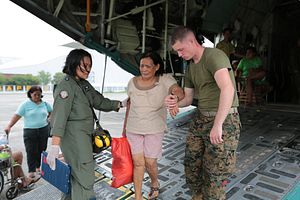More than 6,000 American troops have been deployed in the typhoon-ravaged provinces of Samar and Leyte in central Philippines to assist in the rescue and relief efforts of the local government. In fact, Samar and Leyte are part of U.S. military history. In 1901, American soldiers stood accused of a murderous frenzy in the remote town of Balangiga in Samar. Many years later, in 1944, General Douglas MacArthur returned to the Philippines via Leyte to fight the Japanese invading army.
After learning about the deaths of American soldiers in Samar in 1901, the U.S. government directed its military officials in the Philippines to implement the “most stern measures to pacify Samar” and “to give the Filipinos ‘bayonet rule’ for years to come.” Brig. Gen. Jacob Smith immediately penned his infamous Circular No. 6, which contains the following instructions to his troops: “I want no prisoners” and “I wish you to kill and burn; and the more you burn and kill, the better it will please me.” He ordered his men to reduce Samar into a “howling wilderness” and to kill anyone 10 years old and above capable of bearing arms.
More than 2,000 Balangiga civilians died in the subsequent carnage. Smith was court martialled for his role in this atrocity and it marked the first time that an American officer stood trial for what we now call war crimes. However, the United States continues to refuse to return the church bells of Balangiga, which American soldiers took in 1901 as a war booty.
Fast forward to October 20, 1944. General Douglas MacArthur landed in Palo, Leyte to signal the return of American troops in Philippine soil; and more importantly, to expel the Japanese army that had invaded the country in 1941.
“People of the Philippines, I have returned! By the grace of Almighty God, our forces stand again on Philippine soil,” said MacArthur in a historic radio broadcast. The ensuing Battle of Leyte Gulf involved one of the world’s largest sea battles and the victory of the American forces proved decisive in ending Japanese rule in the Philippines and in Asia. Many Filipinos today continue to regard MacArthur as the “savior of the Philippines.”
In 1991, American troops left the country after the Philippine Senate rejected the bases treaty. That same year, American soldiers were forced to evacuate their base in Pampanga in central Luzon island because of the eruption of Mt. Pinatubo. Two decades later, and another devastating natural disaster has hit the country, this time bringing U.S. forces back to the islands in the Visayas.
When super typhoon Haiyan (Yolanda) struck Samar and Leyte on November 8, the U.S. was among the first countries in the world to offer assistance. Aside from sending cash donations, Washington dispatched its Japan-based military forces to assist in rescue operations, especially in the remote islands of the eastern Visayas region.
The USS George Washington arrived in the country last week with 5,000 sailors aboard. The U.S. also dispatched the USS Germantown and USS Ashland, amphibious warfare vessels that proved very helpful in transporting relief goods to far-flung villages of Samar and Leyte.
By last weekend, the U.S. military had already made 186 aircraft sorties, representing 480 flight hours, and had airlifted nearly 2,900 typhoon victims. Osprey and KC-130 aircraft had delivered 107,000 pounds of food, water and other urgent supplies to the local government.
Aside from the sailors aboard the aircraft carrier, there are more than 600 U.S. military personnel in the Philippines conducting relief services. About 1,000 Marines with the 31st Marine Expeditionary Unit are expected to arrive soon.
Many countries have dispatched troops, but it seems it is the U.S. military that is leading the ground operations. Journalist Terry Moran wrote about how an Israeli officer was instructed by a high-ranking Philippine official “to talk to the Americans” for the coordination in the relief missions
Analysts believe that the active participation of U.S. troops in the rebuilding of typhoon-damaged communities in the Philippines is both a goodwill measure and an effective military strategy at a time when the U.S. is pivoting towards the Asia-Pacific.
Some compare the mercy missions of the U.S. to MacArthur’s historic landing in Leyte. For others, the sight of foreign troops may bring back less pleasant memories. Either way, though, the U.S. is once again poised to make history in Samar and Leyte.
































